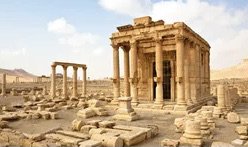Baal worship today
Temple of Baal, Palmyra, Syria.
Baal is the most famous ancient idol symbolized by a bull.
History of Baal worship.
Baal is the most famous idol worshipped in the ancient Middle East. He was the chief god of the Canaanite pantheon including Baal Hadad, Baal Hermon, Baal Tamar, Baal Peor, Baal Zephon & others.
Dates back to the mid 19th century B.C. He is revealed in cuneiform tablets excavated in the ancient city of Ugarit (modern-day Ras Shamra in Syria) beginning in 1929 B.C.
Temple of Baal is in Palmyra Syria.
Baal is the most frequent enemy of Jehovah in the Bible beginning with the golden calf at mount Sinai through the period of the Judges, Kings, exile and post exile. Baal is mentioned 90 times in the Hebrew Bible.
Balaam the wicked prophet that was a worshiper of Baal instructs the Israelites to sin. II Peter 2:15.
Meaning and symbolism of Baal.
Baal a Semitic noun means “owner” or “lord.” Lord of life, fertility and wealth. He was also king of the gods.
Baal’s most common symbol is the bull. Used today as symbol for the stock market and wealth.
The golden calf at mount Sinai. Exodus 32:1-8. The people demanded that Aaron make them a god to worship since Moses had not returned for 40 days. They assumed Moses was dead. Aaron asks for all their gold jewelry, possibly hoping they would decline to do so, but they complied. Aaron then makes the golden calf which represents the best known ancient pagan god.
Current Baal worship.
An individual that turnes from faith in God to worldliness turns to Baal.
A nation founded on Biblical principles that turns to secularism, socialism, materialism and pagan values is practicing Baal worship.
This can be referred to as the return of Baal worship though Baal worship has persisted throughout history.
Baal and Ashtoreth.
Ashtoreth referred to in Judges 2:13-And they forsook the Lord & served Baal and Ashtoreth, also called Ishtar, referred to by some theologians as Mrs. Baal. She is the goddess of unbrideled sexuality.
Ishtar launches the sexual revolution-the great seduction-in all cultures. She is referred to as the harlot goddess. She has also come to Western Civilization and has eroded the Biblical teaching on marriage.
Ishtar is also the goddess of bisexuality and transsexuality including children transsexuality.
Baal, Ashtoreth and Molech.
Molech is mentioned several times in scripture. Molech is Semitic word for Lord. He is the abomination god.
When King Solomon married pagan women and turned away from God, he built altars to the pagan gods including Molech. I Kings 11:7. Molech was the pagan god of human sacrifice.
Leviticus 18:21-thou shall not let any of thy seed pass through the fire to Molech.
When the godly king Josiah sought to lead his nation back to God “He defied Topheth of the sons of Hinnom that no man might make his son or his daughter pass through the fire to Molech”. Molech worship led to the most awful sins-the sacrifice of children.
Jeremiah 32:35 “And they built the high places of Baal which are in the valley of the sons of Hinnom, to cause their sons and daughters to pass through the fire to Molech”.
Baal, Ashtoreth and Molech led the work of the evil spirits recorded in the Old Testament.
Jesus’s parable of the clean house and return of the evil spirits. Matthew 12:43-45, Luke 11:23-26.
The unclean spirit goes out of a man and wanders seeking rest.
The unclean spirit decides to return to the house which is clean and empty.
He takes seven other more wicked, unclean spirits and they enter the house.
The last state of the man is worse than the first.
So shall it be to this wicked generation.
The man is symbolic of the wicked person or generation that turns away from Christ and allows evil spirits to enter including Baal, Ashtoreth and Molech.
The book of Hebrews addresses falling away from the faith: Hebrews 6:4-6.
“Those once enlightened, tasted of the heavenly gifts and were partakers of the Holy Spirit and tasted the good word of God, and the powers of the age to come, and then fell away it is impossible to renew them again to repentance seeing they crucify the Son of God for themselves again, and put Him to open shame.”
The unpardonable sin-: “blaspheme against the holy Spirit” Luke 12:10.
Below is the Audio message.
Posted on Facebook May 6, 2024.

